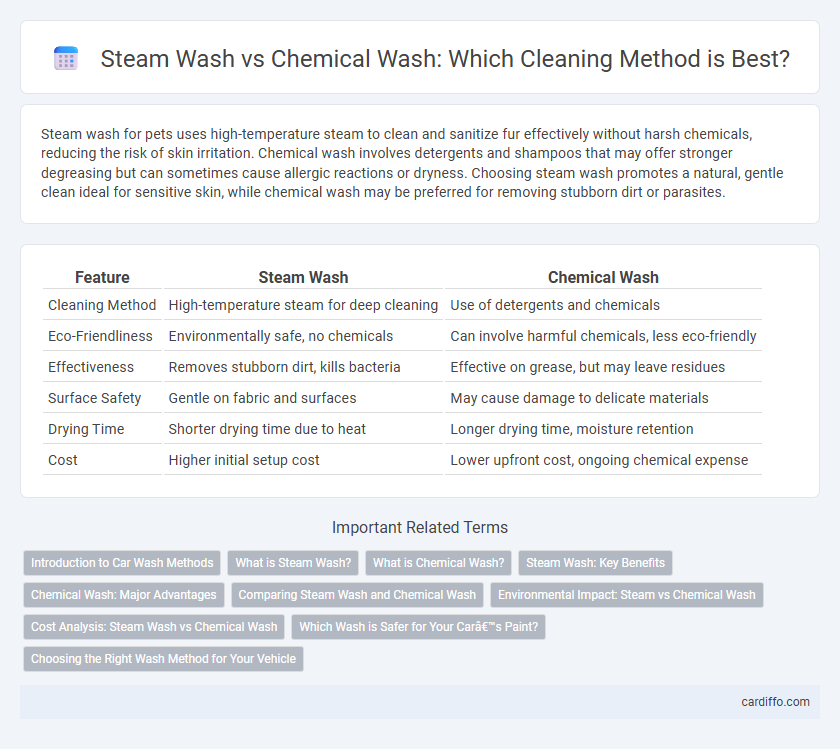Steam wash for pets uses high-temperature steam to clean and sanitize fur effectively without harsh chemicals, reducing the risk of skin irritation. Chemical wash involves detergents and shampoos that may offer stronger degreasing but can sometimes cause allergic reactions or dryness. Choosing steam wash promotes a natural, gentle clean ideal for sensitive skin, while chemical wash may be preferred for removing stubborn dirt or parasites.
Table of Comparison
| Feature | Steam Wash | Chemical Wash |
|---|---|---|
| Cleaning Method | High-temperature steam for deep cleaning | Use of detergents and chemicals |
| Eco-Friendliness | Environmentally safe, no chemicals | Can involve harmful chemicals, less eco-friendly |
| Effectiveness | Removes stubborn dirt, kills bacteria | Effective on grease, but may leave residues |
| Surface Safety | Gentle on fabric and surfaces | May cause damage to delicate materials |
| Drying Time | Shorter drying time due to heat | Longer drying time, moisture retention |
| Cost | Higher initial setup cost | Lower upfront cost, ongoing chemical expense |
Introduction to Car Wash Methods
Steam wash utilizes high-temperature steam to effectively remove dirt and grime while preserving the car's paint and interior surfaces, offering an eco-friendly alternative with minimal water usage. Chemical wash relies on specialized detergents and solvents to break down stubborn stains and contaminants, providing thorough cleaning but often generating more wastewater and potential environmental impact. Both methods balance effectiveness and environmental considerations, with steam wash gaining popularity for sustainable car care.
What is Steam Wash?
Steam wash uses high-temperature steam to clean fabrics, effectively removing dirt, bacteria, and allergens without harsh chemicals. It penetrates deep into fibers, sanitizing and refreshing clothes while reducing water consumption. This method is eco-friendly and ideal for sensitive skin due to its chemical-free cleaning process.
What is Chemical Wash?
Chemical wash involves using specialized detergents, solvents, or acids to remove dirt, stains, and contaminants from fabrics more effectively than steam alone. It targets stubborn residues through chemical reactions that break down oils, grease, and other tough substances embedded in the fibers. This method is commonly employed in industrial laundry settings to achieve deep cleansing and fabric restoration.
Steam Wash: Key Benefits
Steam wash effectively sanitizes surfaces by using high-temperature steam, eliminating up to 99.9% of bacteria and germs without harsh chemicals. This eco-friendly method reduces water consumption by up to 70% compared to traditional chemical washes, making it a sustainable cleaning solution. Steam wash also preserves fabric integrity and color vibrancy, extending the lifespan of garments while offering a hypoallergenic alternative for sensitive skin.
Chemical Wash: Major Advantages
Chemical wash offers major advantages including deep stain removal by breaking down grease, oils, and tough contaminants that steam alone cannot eliminate. It ensures thorough sanitation by targeting bacteria and allergens, providing a higher level of cleanliness for fabrics and surfaces. Chemical wash processes also reduce drying time and prevent water damage, enhancing fabric longevity and maintaining material integrity.
Comparing Steam Wash and Chemical Wash
Steam wash utilizes high-temperature steam to effectively remove dirt, grease, and bacteria from surfaces without harsh chemicals, making it environmentally friendly and safe for various materials. Chemical wash relies on detergents and solvents that can target stubborn stains quickly but may pose risks of residue, surface damage, and environmental harm due to toxic effluents. Choosing between steam and chemical wash depends on the need for eco-friendly cleaning, surface sensitivity, and the type of contaminants involved.
Environmental Impact: Steam vs Chemical Wash
Steam wash significantly reduces environmental impact by using high-temperature vapor to clean surfaces without harmful chemicals, minimizing water consumption and eliminating toxic wastewater discharge. Chemical wash often relies on hazardous detergents and solvents that contribute to water pollution and pose risks to aquatic ecosystems due to toxic runoff. Choosing steam wash promotes sustainable cleaning practices by lowering carbon footprints and reducing chemical contamination in waterways.
Cost Analysis: Steam Wash vs Chemical Wash
Steam wash systems typically incur higher initial investment costs due to specialized equipment and infrastructure requirements, but offer lower operating expenses by reducing water and chemical usage. Chemical wash processes often have lower upfront costs but lead to increased ongoing expenditures from purchasing detergents, handling chemical waste, and potential health and safety compliance. Over time, steam wash can provide cost efficiency through energy savings, reduced chemical disposal fees, and extended fabric lifespan, making it a sustainable option compared to chemical washes.
Which Wash is Safer for Your Car’s Paint?
Steam wash uses high-temperature vapor to clean your car without harsh chemicals, reducing the risk of paint damage and preserving the vehicle's finish. Chemical wash relies on detergents and solvents that can strip protective wax and degrade paint over time if used improperly. Opting for steam wash offers a safer, eco-friendly alternative that maintains your car's paint integrity and minimizes environmental impact.
Choosing the Right Wash Method for Your Vehicle
Steam wash utilizes high-temperature vapor to effectively remove dirt and grease without harsh chemicals, preserving the vehicle's paint and reducing environmental impact. Chemical wash involves powerful detergents and solvents that can tackle stubborn grime but may risk damaging sensitive finishes and require proper disposal to prevent pollution. Selecting the right wash method depends on your vehicle's surface condition, environmental considerations, and the level of cleaning needed for optimal protection and appearance.
Steam Wash vs Chemical Wash Infographic

 cardiffo.com
cardiffo.com